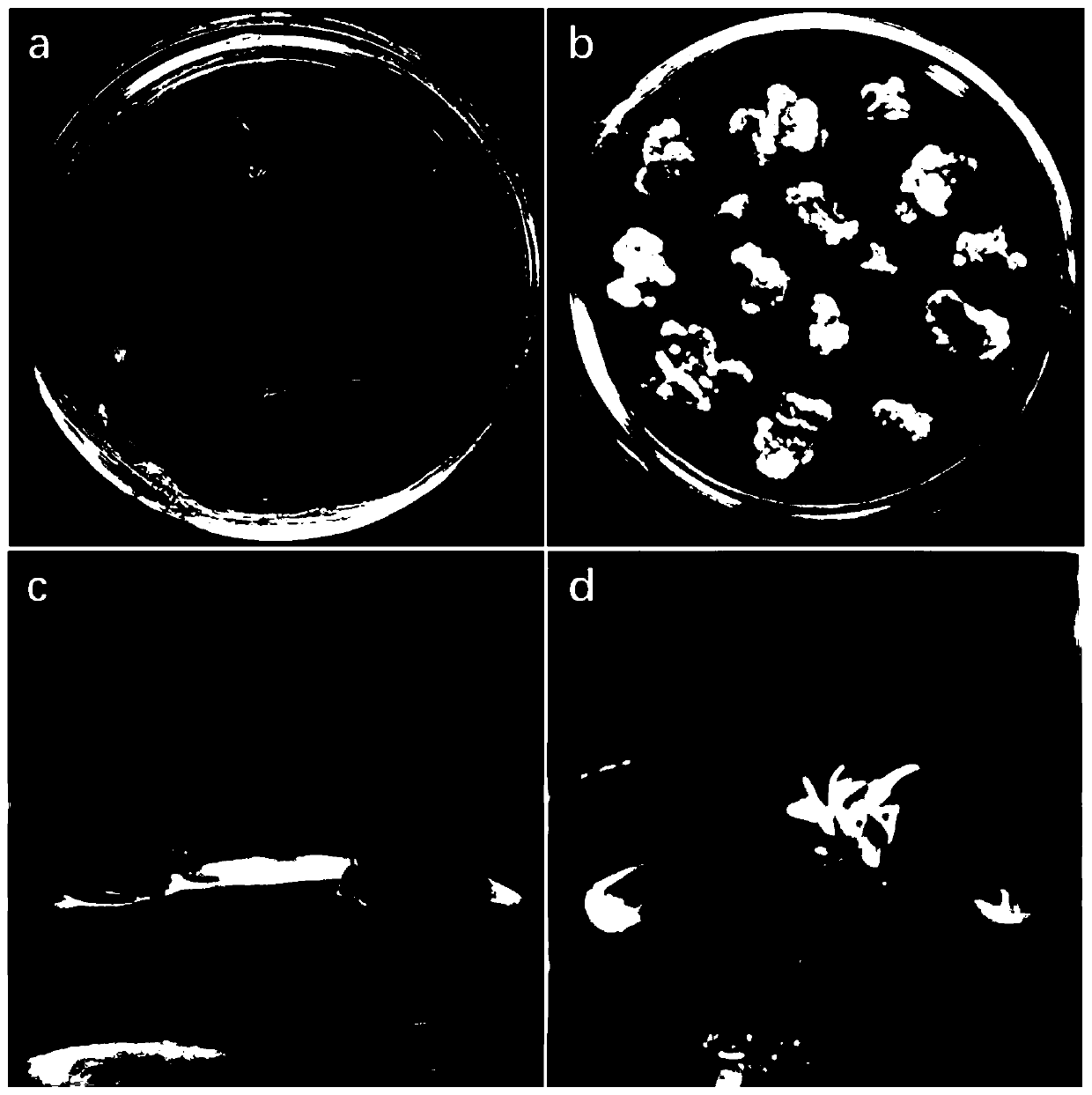Regeneration method of Camellia oleifera regeneration system
A system and technology of Camellia oleifera, applied in the directions of plant regeneration, horticultural methods, botanical equipment and methods, etc., can solve the problems of low callus induction rate, low differentiation rate, can not meet the requirements of factory seedling raising, etc., to improve the induction rate and Differentiation rate, the effect of improving the differentiation rate
- Summary
- Abstract
- Description
- Claims
- Application Information
AI Technical Summary
Problems solved by technology
Method used
Image
Examples
Embodiment 1
[0032] Present embodiment provides a kind of regeneration method of camellia oleifera sheet, as figure 1 shown, including:
[0033] (1) Disinfection of explants
[0034] Pick the young leaves of common Camellia oleifera 'Changlin No. 4', soak in detergent for 5-10 minutes, then rinse with tap water for 1-2 hours, and dry the water with absorbent paper. On the ultra-clean workbench, soak the leaves with 70%-75% alcohol for 10-30s, wash them with sterile water for 3-4 times, then disinfect the surface with 0.08-0.12% HgCl2 for 8-12min, and then wash them with sterile water Wash 6-8 times.
[0035] (2) Callus induction culture
[0036] The specific cultivation includes: putting the leaves on sterile filter paper, drawing 2-4 lines perpendicular to the main vein in the middle of the leaves with a scalpel, and then peeling off the leaves with tweezers to inoculate the leaves on the callus induction medium. 3-8 leaves were inoculated per dish (90 mm). Place the inoculated cultu...
Embodiment 2
[0050] The present embodiment provides a kind of regeneration method of camellia oleifera sheet, comprising:
[0051] (1) Callus induction culture
[0052] The leaf material is the leaf of the aseptic tissue culture seedling of 'Changlin No. 4' common Camellia oleifera, and the specific cultivation is as in Example 1.
[0053] The callus induction medium is: 1 / 2MS basic medium (powder), 1.0mg / L of 2,4-D, 0.5mg / L of TDZ, 50g / L of sucrose, 8g / L of agar, 250mg / L hydrolyzed casein, 250mg / L hydrolyzed milk protein, 100mg / L proline, 100mg / L glycine, 100mg / L glutamine, 100mL / L coconut water, and 1g / L PPVP and 10mg / L silver nitrate, and adjust the pH to 5.6; the callus induction rate is 100%.
[0054] (2) Callus differentiation culture
[0055] The specific culture is as in Example 1.
[0056] The differentiation medium is: 1 / 2MS medium (powder), 0.05mg / L NAA, 1.0mg / L 6-BA, 0.05mg / L TDZ, 30g / L sucrose, 7g / L agar , 300mg / L hydrolyzed casein, 300mg / L hydrolyzed milk protein, 150mg...
Embodiment 3
[0062] The present embodiment provides a kind of regeneration method of camellia oleifera sheet, comprising:
[0063] (1) Callus induction culture
[0064] The leaf material is the leaf of the aseptic tissue culture seedling of 'Changlin No. 4' common Camellia oleifera, and the specific cultivation is as in Example 1.
[0065] The callus induction medium is: 1 / 2MS basic medium (powder), 1.0mg / L of 2,4-D, 1.0mg / L of TDZ, 70g / L of sucrose, 8g / L of agar, 500mg / L hydrolyzed casein, 500mg / L hydrolyzed milk protein, 150mg / L proline, 150mg / L glycine, 150mg / L glutamine, 100mL / L coconut water, and 2g / L PPVP and 10mg / L silver nitrate, and adjust the pH to 5.8; the callus induction rate is 100%.
[0066] (2) Callus differentiation culture
[0067] The specific culture is as in Example 1.
[0068] The differentiation medium is: 1 / 2MS medium (powder), 0.05mg / L NAA, 2.0mg / L 6-BA, 0.01mg / L TDZ, 300g / L sucrose, 7g / L agar , 500mg / L hydrolyzed casein, 500mg / L hydrolyzed milk protein, 200m...
PUM
 Login to View More
Login to View More Abstract
Description
Claims
Application Information
 Login to View More
Login to View More - R&D
- Intellectual Property
- Life Sciences
- Materials
- Tech Scout
- Unparalleled Data Quality
- Higher Quality Content
- 60% Fewer Hallucinations
Browse by: Latest US Patents, China's latest patents, Technical Efficacy Thesaurus, Application Domain, Technology Topic, Popular Technical Reports.
© 2025 PatSnap. All rights reserved.Legal|Privacy policy|Modern Slavery Act Transparency Statement|Sitemap|About US| Contact US: help@patsnap.com

